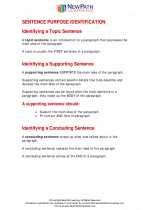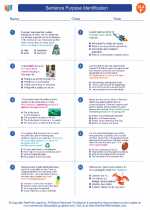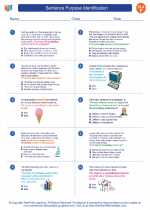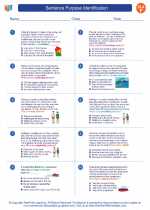Sentence Purpose Identification
Topic Sentence. A topic sentence is an introduction to a paragraph that expresses the main idea of the paragraph. Supporting sentence. A supporting sentence supports the main idea of the paragraph. Concluding sentence. A concluding sentence wraps up what was talked about in the paragraph. Read More...
◂English Language Arts Worksheets and Study Guides Sixth Grade. Sentence Purpose Identification
Study Guide Sentence Purpose Identification
Sentence Purpose Identification  Worksheet/Answer key
Worksheet/Answer key Sentence Purpose Identification
Sentence Purpose Identification  Worksheet/Answer key
Worksheet/Answer key Sentence Purpose Identification
Sentence Purpose Identification  Worksheet/Answer key
Worksheet/Answer key Sentence Purpose Identification
Sentence Purpose Identification 

 Worksheet/Answer key
Worksheet/Answer key
 Worksheet/Answer key
Worksheet/Answer key
 Worksheet/Answer key
Worksheet/Answer key

The resources above cover the following skills:
Reading Standards for Literature
Key Ideas and Details
Cite textual evidence to support analysis of what the text says explicitly as well as inferences drawn from the text. [RL.6.1]
Reading Standards for Informational Text
Key Ideas and Details
Cite textual evidence to support analysis of what the text says explicitly as well as inferences drawn from the text. [RI.6.1]
Determine a central idea of a text and how it is conveyed through particular details; provide a summary of the text distinct from personal opinions or judgments. [RI.6.2]
Analyze in detail how a key individual, event, or idea is introduced, illustrated, and elaborated in a text (e.g., through examples or anecdotes). [RI.6.3]
Writing Standards
Text Types and Purposes
Write informative or explanatory texts to examine a topic and convey ideas, concepts, and information through the selection, organization, and analysis of relevant content. [W.6.2]
Provide a concluding statement or section that follows from the information or explanation presented. [W.6.2f]
Write narratives to develop real or imagined experiences or events using effective technique, relevant descriptive details, and well-structured event sequences. [W.6.3]
Provide a conclusion that follows from the narrated experiences or events. [W.6.3e]